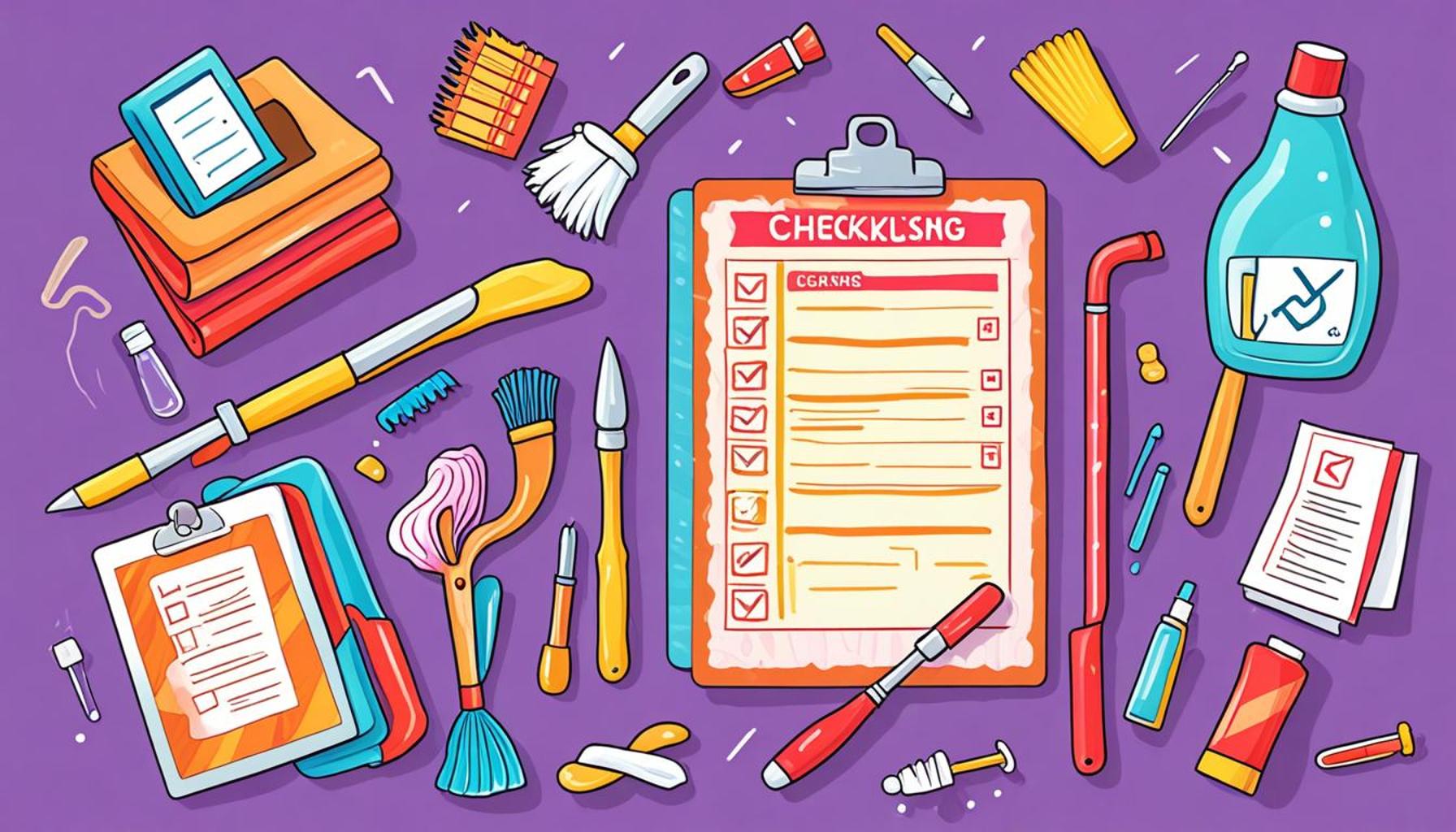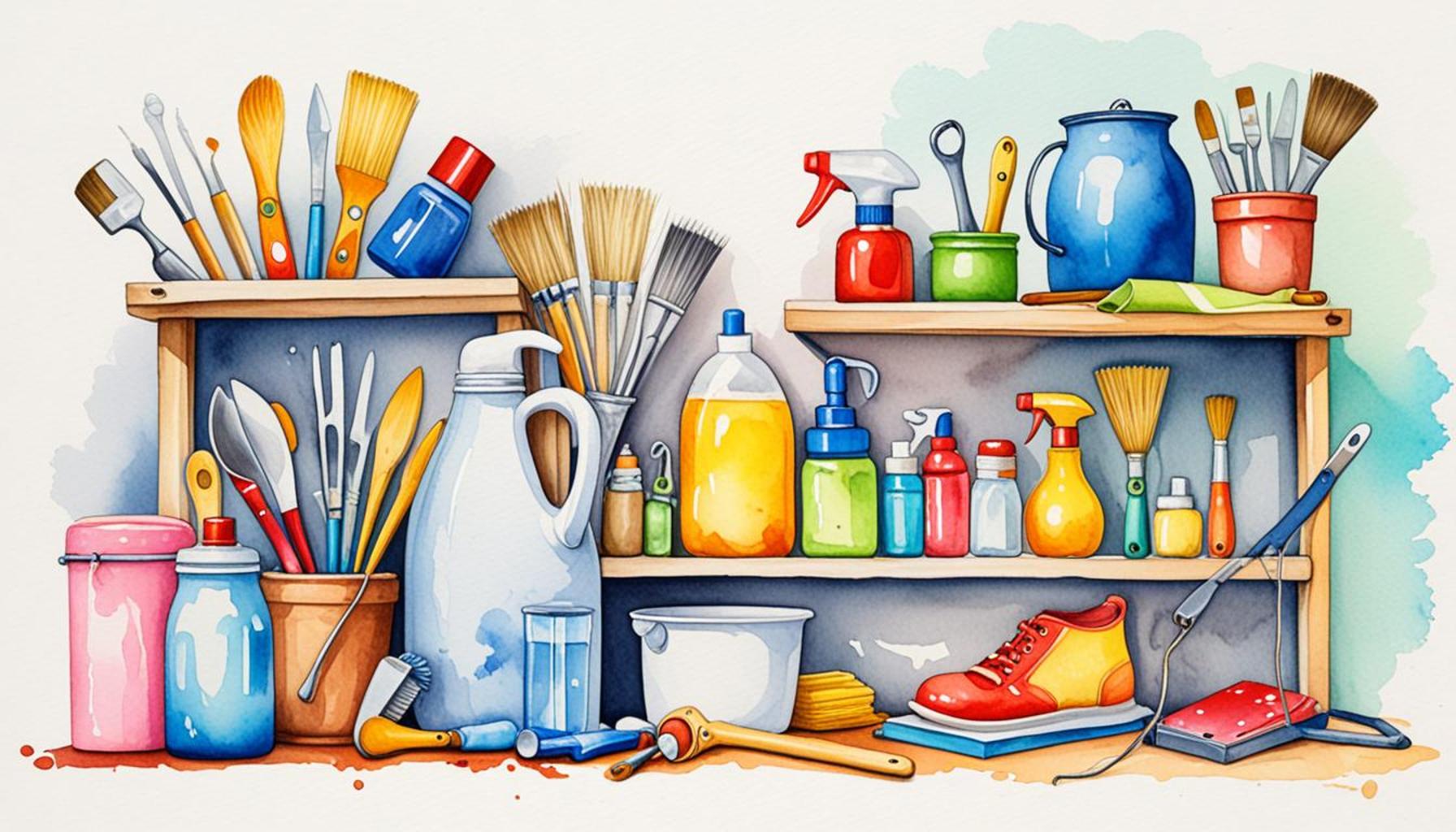How to Use Checklists to Keep Your Home Clean and Optimize Time

Unlock the Power of Checklists
Checklists serve as invaluable instruments for enhancing organization and productivity in our daily lives, especially within the context of home management. In a world where multitasking is ubiquitous, these systematic tools can help individuals regain control and foster a sense of accomplishment. Whether you are juggling work commitments, family responsibilities, or personal projects, integrating checklists into your routine can lead to tangible improvements in efficiency and cleanliness.
Consider the following key benefits of using checklists for home cleaning:
- Focus and Clarity: By breaking down chores into clear, actionable tasks, checklists help you zero in on one job at a time. For instance, if you’re cleaning the kitchen, instead of feeling overwhelmed by the entire process, a checklist allows you to focus solely on specific tasks—like wiping countertops, cleaning the stove, or loading the dishwasher—making the entire endeavor less daunting.
- Minimize Overwhelm: Large cleaning tasks can often feel insurmountable, leading many to procrastinate. A checklist simplifies these into manageable steps. For example, rather than saying “clean the living room,” you might note tasks such as “vacuum the carpet,” “dust shelves,” and “arrange cushions.” This not only makes the task feel less intimidating but also paves the way for steady progress.
- Boost Motivation: There’s a psychological satisfaction associated with crossing off completed tasks. This small win can trigger a more productive mindset, encouraging you to tackle the next item. Research has shown that this practice can significantly enhance motivation and commitment towards completing larger objectives.
Creating customized checklists tailored to specific areas of your home can lead to a more organized environment. Consider these common checklist categories that many households can benefit from:
- Daily Cleaning Tasks: This checklist might include must-do items like making the bed, washing dishes, and wiping down surfaces, establishing a routine that fosters cleanliness on a regular basis.
- Weekly Deep Clean Schedule: A more comprehensive checklist that outlines tasks such as mopping floors, vacuuming upholstery, and cleaning windows can ensure no area is neglected.
- Seasonal Maintenance Checklist: This can help you stay ahead of seasonal chores, like deep-cleaning your gutters in the fall or checking smoke detectors in spring, protecting your home year-round.
As you complete each task on your checklist, the feeling of accomplishment goes beyond just a tidier home—you start to reclaim precious time and mental space. Furthermore, to truly optimize the checklist process, consider utilizing digital tools like mobile apps, which can store your lists and send reminders, ensuring you never miss a step. Such functional checklists can be seamlessly integrated into your daily routine, making them not just a tool for cleaning, but a lifestyle enhancer that fosters greater overall well-being.
DISCOVER MORE: Click here for expert tips on time management for home maintenance

Crafting Effective Checklists for Home Cleaning
To harness the true potential of checklists for maintaining a clean home and optimizing your time, it is essential to craft them carefully and strategically. The art of creating effective checklists lies in understanding your specific cleaning needs and tailoring your lists accordingly. Below are some practical tips to help you design checklists that resonate with your daily routine and household dynamics.
Assess Your Cleaning Areas
Before setting pen to paper—or fingers to keyboard—spend a moment assessing the various spaces within your home that require attention. Each room has unique requirements, and identifying these will help streamline your checklist creation process. For example, the kitchen may demand more focused sanitation tasks than a rarely-used guest room. By breaking down your home into distinct areas, you can prioritize and allocate time effectively. Here are some common areas to consider:
- Living Room: Dust surfaces, organize magazines, vacuum carpets, and declutter electronics.
- Bedrooms: Change bed linens, dust furniture, and clean out closets to keep storage manageable.
- Bathrooms: Scrub toilets, clean mirrors, and ensure that toiletries are neatly arranged and stocked.
- Hallways: Sweep or vacuum floors, and tidy any shoes or items that may accumulate.
Designate Task Frequencies
Another critical aspect of creating beneficial cleaning checklists is determining how often specific tasks need to be performed. Some chores are evidently more frequent than others, and organizing them by frequency helps save time and maintain cleanliness consistently. Here’s a breakdown of how to categorize tasks:
- Daily Tasks: Activities that should be done every day, such as making the bed, washing dishes, and taking out the trash.
- Weekly Tasks: These might include mopping floors, vacuuming, and cleaning bathrooms, scheduled to maintain a more profound level of cleanliness.
- Monthly or Seasonal Tasks: This could cover deep-cleaning carpets, washing windows, or organizing storage areas, ensuring that every corner of your home looks its best.
Incorporating Digital Tools
In today’s tech-savvy world, consider harnessing the power of digital tools to enhance the effectiveness of your checklists. Mobile applications specifically designed for task management can streamline the process, offering features that allow you to create, maintain, and automatically update your cleaning schedules. Features such as reminders, alarms, and customizable checklists increase the likelihood of your adherence to the cleaning regimen. Popular apps like Todoist, Trello, or even basic note-taking applications can elevate your checklist game.
By implementing these strategies into your cleaning routine, you create a structured environment that not only fosters cleanliness but optimizes your time. With the right checklists in place, you will find yourself moving from one task to another with greater efficiency, paving the way for a more organized and serene living space.
| Category | Advantages |
|---|---|
| Time Management | Increases efficiency by allowing you to allocate specific times for tasks. |
| Prioritization | Helps in identifying first things first, ensuring essential tasks are completed promptly. |
| Active Monitoring | Promotes accountability by tracking completed tasks and allowing for timely adjustments. |
| Reduced Stress | Lessens overwhelm as you have a clear plan to follow, knowing that all tasks are documented. |
Incorporating checklists in your daily cleaning routine serves as an excellent method for optimizing time management. By breaking down cleaning tasks into specific segments, you gain a clearer view of what needs to be accomplished, thus increasing your efficiency. Checklists also empower you to prioritize your chores based on urgency and importance, ensuring that high-priority items are tackled first. Moreover, actively monitoring your progress offers a sense of accountability; you can revise your approach if necessary.Beyond enhanced organization, one of the most notable benefits is the reduction in stress levels associated with cleaning. With a clear plan laid out before you, the entire process feels less daunting. The simple act of checking off completed tasks brings a rewarding sense of accomplishment, not merely as a way to manage your home, but to optimize your time for activities that truly matter.Embracing checklists could be the transformative change needed to maintain a clean home while freeing up precious moments for family, relaxation, or hobbies.
DON’T MISS: Click here to learn how to create a flexible maintenance plan
Maximizing the Benefits of Checklists for a Clean Home
Checklists are not just simple lists; they can transform your cleaning habits into efficient routines that save both time and effort. To fully leverage the potential of your checklists, consider integrating the following strategies that can enhance their effectiveness and keep your home spotless.
Prioritize Tasks with the Eisenhower Matrix
One innovative strategy to consider is implementing the Eisenhower Matrix to prioritize your cleaning tasks. This method encourages you to categorize your chores into four areas: urgent and important, important but not urgent, urgent but not important, and neither urgent nor important. By doing so, you can focus on tasks that require immediate attention and set aside those that can wait. For instance, cleaning a spill in the kitchen may fall under urgent and important, while planning a garage clean-out may be deemed important but not urgent. This organization lowers stress and fosters a more strategic approach to everyday household maintenance that allows you to optimize your time effectively.
Involve Family Members
Cleaning should not solely rest on one person’s shoulders, especially in larger households. Engaging family members in the cleaning process can distribute the workload, making it feel less overwhelming. Create a cleaning checklist that assigns specific tasks to each member of the family while considering their strengths and preferences. For example, one person may thrive at organizing the backyard while another prefers tackling the laundry. By fostering teamwork, you not only promote cooperation but also make the cleaning process more enjoyable. Additionally, consider a reward system to incentivize participation, which may encourage everyone to contribute more willingly.
Tracking Progress and Celebrating Small Wins
Another vital aspect of maintaining motivation is the practice of tracking progress. Checklists provide an excellent platform for noting completed tasks, which can empower you. Set aside time to review your checklist weekly or bi-weekly, reflecting on all the tasks accomplished. Celebrating small wins—whether it’s a particularly deep clean of the bathroom or successfully decluttering a closet—gives a sense of achievement and encourages continuous commitment to home cleanliness. You may choose to jot down these accomplishments in a dedicated section of your checklist or start a “cleaning journal” that marks the journey of transforming your home.
Adjusting Checklists Based on Seasonal Needs
As the seasons change, so do the demands of home maintenance. Dust accumulates differently in summer, while winter may call for more focus on indoor spaces. Adapt your checklists to reflect these shifts in seasonal cleaning requirements. Creating dedicated seasonal checklists helps ensure that your home remains in top condition throughout the year. For example, spring cleaning may require tasks like washing screens, organizing outdoor spaces, and deep-cleaning carpets, whereas autumn tasks may focus on preparing your home for colder months, such as cleaning gutters and ensuring heating systems function properly.
Incorporating Minimalist Principles
Finally, consider aligning your checklist with minimalist principles to further simplify home upkeep. Embrace the idea of “less is more” to lessen both clutter and cleaning time. Reducing excess items simplifies your living space and minimizes the tasks on your checklist. Less clutter not only enhances the cleanliness of your home but also fosters a sense of calm and clarity. As you assess each room, ask whether each item serves a purpose or brings you joy. This practice aligns perfectly with keeping your home clean and optimizing time as it creates a more manageable environment.
By incorporating these strategies into your cleaning checklists, you can cultivate a more structured and efficient cleaning routine that adapts to your family’s needs and the changing seasons while simultaneously maintaining an inviting home.
DISCOVER MORE: Click here to learn about the importance of preventive maintenance
Conclusion: Transforming Home Cleaning with Checklists
Utilizing checklists is a powerful method to streamline your cleaning routine and enhance your home’s cleanliness while optimizing your time. By implementing the strategies discussed in this article, such as prioritizing tasks with the Eisenhower Matrix, engaging family members in cleaning responsibilities, tracking progress, adjusting for seasonal needs, and embracing minimalist principles, you can achieve a more organized and manageable approach to home maintenance. These techniques not only make cleaning feel less daunting but also instill a sense of accomplishment as you witness tangible improvements in your living space.
Moreover, adopting a checklist mindset fosters accountability and collaboration within households, breaking down daunting chores into achievable tasks. This team-oriented approach transforms cleaning from a solitary and overwhelming responsibility into a shared experience that can strengthen family bonds. As you celebrate small victories and continuously refine your checklists, you’ll develop a personalized system that caters to your unique needs.
Ultimately, the journey toward a cleaner home and efficient time management begins with the simple act of creating and utilizing checklists. By embracing these organizational tools, you are not only investing in a cleaner environment but also cultivating habits that make housekeeping a seamless part of your daily life. So, take the first step—create your checklist today and enjoy the clarity and peace that comes with a clean home.


